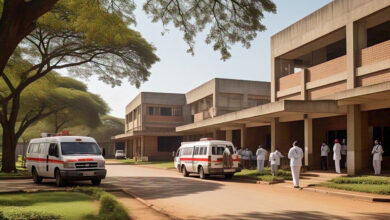Revitalising Zimbabwe’s Rural Healthcare Infrastructure: Modernizing Rural Health Facilities for Sustainable Growth

Zimbabwe’s rural healthcare infrastructure is the backbone of public health in many remote communities and revitalising it remains an urgent priority. In today’s dynamic environment, rebuilding and modernising rural health facilities in Zimbabwe demands sustainable solutions and robust community engagement.
As new clinics and renovated hospitals take shape, we witness the convergence of innovative construction methods with the proven wisdom of community-based care. Through targeted investments and modern techniques, Zimbabwe’s rural healthcare infrastructure is steadily evolving into a model of efficiency and resilience.
Construction of New Facilities and Renovation Priorities
Firstly, constructing brand-new clinics using eco-friendly materials is essential. Modern facilities designed with energy-efficient technologies—such as solar power and rainwater harvesting—help reduce operating costs and carbon footprints. Consequently, these state-of-the-art structures not only bolster Zimbabwe’s rural healthcare infrastructure but also create appealing work environments for skilled professionals.
Meanwhile, renovating older establishments remains equally important. Upgrading dated buildings to meet modern standards can be achieved by focusing on energy efficiency, improved sanitation, and reliable water supplies. These renovations ensure that the legacy of Zimbabwe’s rural healthcare infrastructure is preserved while adapting to current clinical needs.
Moreover, reputable sources like the World Health Organization and the World Bank have highlighted the significance of sustainable facility development in low-resource settings.
Enhancing Rural Health Facilities in Zimbabwe
In parallel, prioritising the construction of new health facilities and systematic renovation projects is only part of the equation. Strategic planning must address staffing requirements to ensure that every new or improved facility can operate optimally. A solid workforce is the cornerstone of an effective healthcare system. Therefore, developing comprehensive training programs and improving working conditions in rural areas will result in a more resilient Zimbabwean rural medical infrastructure.
For example, international collaborations with academic institutions and health organisations have made significant strides in capacity development. Additionally, dedicated initiatives promise long-term staff retention by providing incentives and continuous professional development, thereby reinforcing Zimbabwe’s rural healthcare infrastructure.
Investing in Human Resources for a Zimbabwe Rural Health Network
Furthermore, bolstering human capital remains critical. Healthcare workers need regular training and support to address the unique challenges of remote areas. Thus, government agencies and non-profit organisations are increasingly investing in specialised training programs. As a result, skilled personnel not only manage the current workload but also prepare for future healthcare challenges.
This focus on staff development transforms the entire rural healthcare development in Zimbabwe, ensuring that patients receive quality care no matter where they are. It also creates a positive cycle by improving service quality, which in turn attracts additional funding and elevates local morale. More importantly, newly established partnerships with reputable entities like UNICEF further entrench these training initiatives.
Innovative Maintenance Funding Models for Zimbabwe’s Rural Healthcare Infrastructure
In addition, securing sustainable funding for maintenance is a linchpin in ensuring the longevity of rural medical infrastructure. Diverse funding models that combine public funds, private investments, and community-based contributions can help stabilise operations. For example, public‐private partnerships have emerged as a promising solution to finance routine maintenance and unexpected repairs alike.
Furthermore, transparent financial governance allows stakeholders to trust that their contributions directly improve Zimbabwe’s rural healthcare infrastructure. Equally important are international aid programmes, which have provided significant resources to help these initiatives flourish. Therefore, embracing innovative financing solutions is crucial for maintaining high-quality services at newly built and renovated facilities alike.
Community Engagement and Digital Innovations in a Zimbabwe Rural Health Network
Moreover, community engagement is indispensable in transforming Zimbabwe’s rural healthcare infrastructure. Local residents are not passive recipients; they actively contribute to the planning, management, and maintenance of their health facilities. By integrating community feedback in both construction and renovation phases, policymakers ensure that projects remain culturally relevant and responsive to unique needs.
Additionally, digital innovations like telemedicine and electronic health records narrows the gap between rural and urban healthcare. These technologies expedite diagnosis and treatment, thereby reinforcing the overall efficiency of Zimbabwe’s rural healthcare infrastructure. Importantly, community liaisons and locally elected advisory groups further enhance accountability.
Together, these efforts forge a robust Zimbabwe rural health network where every stakeholder works in harmony. Resources such as The United Nations emphasise that community involvement is the cornerstone of sustainable development.
Sustainable Energy Solutions and Preventative Maintenance
Besides human capital and funding models, sustainable energy solutions are also pivotal. Converting rural facilities to renewable energy sources like solar power not only cuts operating expenses but also creates a resilient power supply for critical services. In addition, scheduled preventative maintenance ensures that equipment remains in optimal condition.
As maintenance protocols are standardised, minor repairs are handled swiftly before they escalate into costly failures. Furthermore, by adopting such modern solutions, Zimbabwe’s rural healthcare infrastructure continues to evolve into a robust rural medical network in Zimbabwe. In the long run, investments in technology catalyse improvements in overall service delivery.
Conclusion: Forging a Legacy of Resilience
Ultimately, the revitalisation of Zimbabwe’s rural healthcare infrastructure demands a multi-pronged approach. Strategies that combine innovative construction, focused facility renovation, enhanced staffing requirements, and innovative maintenance funding models are essential. Moreover, it is equally vital to foster community engagement to ensure that improvements are both culturally sensitive and practically effective. With each new health facility constructed and each older facility renovated, Zimbabwe not only improves its rural healthcare infrastructure but also builds a lasting legacy of strength and resilience. As every stakeholder—from government officials to local community members—contributes their energy and expertise, the dream of accessible, modern healthcare for all Zimbabweans remains within reach.
In summary, the ongoing transformation of Zimbabwe’s rural healthcare infrastructure underscores the importance of sustainable planning and community collaboration. This vision, bolstered by innovative funding models and digital integration, promises to turn existing challenges into opportunities. The collective effort paves the way for a future where every rural health facility in Zimbabwe becomes a beacon of hope for a healthier, more prosperous nation.





